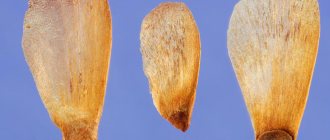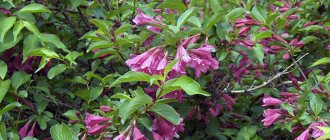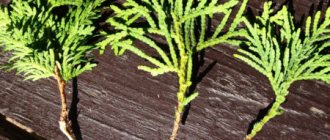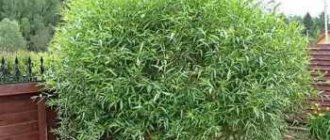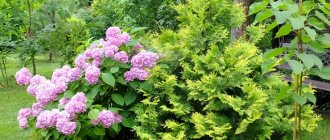Propagate beautiful hydrangeas for free in a couple of weeks in 2 easy steps! Start rooting plants with the secret to trouble-free propagation!
An easy way to multiply your favorite hydrangea varieties: propagate the plant by cuttings! Like many amateur gardeners, you can never have enough hydrangeas as they come in so many different shapes and shades!
Hydrangeas are a perennial favorite in English gardens and farmlands! Hydrangeas make a great gift for friends who love growing flowers!
Each of us can purchase 50 varieties of hydrangea or exchange with gardening friends and propagate hydrangeas by cuttings at home!
All types of hydrangeas, from the spectacular bigleaf hydrangea (Hydrangea macrophylla) to the delightful tree-like hydrangea (Hydrangea arborescens), are easy to propagate. Cuttings propagated last summer begin to bloom next year!
Selection of cuttings
To give hydrangea cuttings the best chance to take root, choose healthy plants that are free of pests (aphids) or disease. You can propagate flowering and non-flowering stems; it is better to choose stems without flower buds.
Helpful tip: Don't let the cuttings dry out during the process. Work quickly in a shaded area.
Choose tender green stems 7 to 12 centimeters long, which root faster and easier than woody stems. The cut is made below the leaf node. Hydrangea cuttings should have at least 3 sets of node leaves - see photo above.
Trim all but the top two leaves (or four leaves if the top two leaves are smaller than the middle one) from the stem using clean, sharp pruning shears. Work carefully so as not to scratch or damage the main stem.
When propagating hydrangea varieties with large leaves 7 cm in diameter or more, the remaining two large leaves are shortened by half - this will reduce the load on the cuttings to absorb water. For hydrangeas with small leaves, you can leave whole leaves.
Reproduction methods
Using cuttings is not the only option. Alternative technologies are used taking into account the climate and the demands of the variety.
| By shoots | Bends | Dividing the bush | Seeds |
| Least effective method. | Conducted in spring or early autumn. | Carry out until the third decade of September. | It will require several times more time from the gardener. |
| The procedure is not always effective after the hydrangea has finished flowering. | For manipulation, take strong shoots. They should not show signs of illness. | Low germination rate. |
On a note! Botanists analyzed the methods of reproduction. They concluded that using cuttings is the most effective option in all respects.
How to root hydrangea cuttings
To quickly root cuttings, root formation stimulants are used.
You don’t have to use stimulants, then rooting will take longer. Hydrangea is easy to root if you use the greenhouse described below.
Place some rooting powder in a dry zip-top bag, dip the cuttings in water, shake off excess water, and place the stems inside the bags. Shake the bag until the stems are coated with powder.
Leave the bag open for a few hours to allow the moisture to evaporate and seal the bag with the remaining rooting hormone powder for reuse next time.
Using a stick or pencil, make a hole in the moist soil mixture and insert each cutting into the hole. Gently compact the soil to secure each seedling. Place the seedlings at a distance of at least 3-5 cm from each other.
You need to bury 1, preferably 2 sets of nodes in the soil. New roots will grow from the nodes!
There are several good substrate options for rooting cuttings. A mixture for sowing seeds and good flower soil are also suitable.
Do not use garden soil or potting mix with too much manure or fertilizer, too much nutrients will cause the cuttings to rot. A soilless mixture of 50% peat moss (soak in water for 30 minutes before use) and 50% perlite is an excellent propagation mixture.
The easiest and best way to propagate using a greenhouse!
A large 45 cm transparent plastic container with a lid is used as a mini-greenhouse. After planting in the moist mixture, the cuttings are placed inside the container, lightly sprayed and covered with a lid.
The cuttings are checked once a week. You may need to spray the substrate from time to time. It is necessary to water frequently and keep hydrangea seedlings moist at all times, not wet. Store the container with the cuttings in a bright, warm place, away from direct sunlight.
After about ten days, the hydrangea cuttings will begin to form new roots. In 4-6 weeks a healthy root system will form and the cuttings can be planted in the garden or in a larger container.
The planted cuttings are well watered for the first 2 weeks. Once they become more resilient, less maintenance will be required. Hydrangeas love dappled shade and moist soil.
Autumn cuttings of hydrangea - pros, cons, features
The cutting method for propagation can be used for hydrangea both in spring and summer, and even in autumn - unlike many garden flowers and shrubs. The main difference between the seasons is that in spring and summer, green and semi-lignified cuttings are used, and in the fall, lignified, bark-covered cuttings are used (although they take root a little worse). In addition, cutting hydrangea in the fall involves long-term cultivation of planting material at home in boxes or containers, followed by planting in open ground.
Since it’s autumn, we’ll look at this last option. Propagation by cuttings is equally suitable for all types of hydrangea - tree-like, paniculate and large-leaved. The optimal time for autumn cuttings of any hydrangea is the end of September/beginning of October.
What are the advantages of autumn cuttings of hydrangeas?
- you can use bush branches after its obligatory autumn pruning - usually they are burned or end up in compost;
- in winter (as opposed to the busy and busy spring-summer period for a gardener), there is time and energy to control the growth and development of seedlings;
- in the spring you receive already grown, healthy and strong planting material.
The plantings require careful care throughout the winter, and only in the spring, after the threat of frost has passed, are rooted hydrangea seedlings planted in the garden. Let's look at the cutting process step by step.
In addition to cuttings, there are 4 more ways to propagate hydrangea in spring and autumn
Propagation by seeds
The seeds are sown in boxes without going deep into the ground, only lightly sprinkled with the mixture, sprayed and covered with a bag or glass. The soil is kept constantly moist. Shoots appear in 3-4 weeks, the seedlings grow for a couple of years and are planted in a permanent place in the 3rd year.
Disadvantages: when sown with seeds, only natural species retain their decorative features; varieties are hybrids and lose their characteristic features when propagated by seed.
Reproduction by layering
The procedure is carried out in early spring before the buds open.
The soil around the bush is dug up, leveled and radial grooves are made, shoots from the lower part of the bush are placed in them and sprinkled with earth. On the layering, before the first developed bud, a constriction is made of several turns of soft wire.
By the end of summer - beginning of autumn, young shoots form on the layering, when they reach 20 cm in height, they need to be hilled once a week until the mound increases to 30 cm.
The cuttings are dug up and separated when the young specimens reach 50 cm. The seedlings are transplanted to a permanent place after a year.
Dividing the bush
Before the procedure (in early spring), the bush is watered abundantly, the roots are dug up and washed from the soil. Divide the bush into several parts with sharp pruning shears, trimming the ends of the shoots and roots, and plant it in a permanent place.
Reproduction by offspring
In autumn, the top layer of soil is removed and the shoots are separated from the mother plant. Planted in the garden for 1-2 years before planting in a permanent place.
Preparing for planting in the ground
Young hydrangeas with established roots can only be planted the next year. Before that, you should take care of the plant in advance of winter.
There are 2 options:
- bury the container with the bush in the ground so that it does not freeze, but it is better to do this in a greenhouse;
- reduce the frequency and volume of watering, and then move the cutting to the cellar or basement.
At the first signs of growth in spring, the soil begins to be watered moderately. In essence, the plant is ready for planting. Before placing it in the planting hole, add a complex mineral product containing potassium, phosphorus and nitrogen, and 2-3 days before this, the bush is stopped irrigated - this is necessary in order to easily remove it from the container along with the soil lump. Immediately after planting, to create a beautiful crown, the hydrangea is cut to 2/3 of the height of the bush.
If you follow the instructions correctly, observing the rules of cuttings, using this method it is possible to grow a high-quality ornamental shrub that will decorate the area with lush flowers of magical beauty all summer long.
See below for information on cuttings from hydrangea.
Propagation of hydrangea by cuttings - how to do it correctly in the fall
Hydrangea is a chic decoration for a personal plot. Large bushes with large inflorescences of interesting colors attract attention, please the eye, and cause admiration. Of course, I would like to have more similar plants. Hydrangeas reproduce well by cuttings, therefore, having one healthy representative of the species, over time you can plant the entire garden with its offspring. Let's look at the work schemes for a number of cutting methods and the rules for their implementation.
In addition to cuttings, hydrangea is propagated by seeds, dividing the bush, and layering. They are complex and time-consuming, although they give the desired effect. Working with cuttings is easier; the method gives positive results and does not require complex skills; it is suitable even for novice gardeners.
Peculiarities of propagation of different plant varieties
There are many types of hydrangea, but most often gardeners prefer several of them because they do not require special cultivation and care skills. But the characteristics of reproduction may vary:
- For large-leaf or garden hydrangea, you can use any of the methods. But only this species is a little sensitive, so it is better to stop at replanting by dividing the bush or green summer cuttings. You can start doing all the work in June and until the end of September. After propagation in the fall, garden hydrangea must be wrapped for the winter. This applies to both young shoots and adult bushes.
- Tree hydrangea can be propagated in almost all ways, the only exception being dividing the bush. To carry out the procedure, the bush needs to be dug up. This variety is quite large and does not like interference with the root system. The plant blooms better when left undisturbed. If you replant a plant, it may not bloom for a couple of years. It is preferable to propagate this variety by green layering, which bends easily and does not break. Until they take root, they must be covered with film. For the winter, young shoots are protected.
- Paniculate hydrangea is a beautiful and fragrant plant, but it has too short a time to reproduce. It is very important to carry out all the work on time, otherwise the procedure will not be successful. The optimal time for propagation occurs when the root of the bush has absorbed a sufficient amount of water. In mid-Russian latitudes, this time begins in mid-June. It is better to take cuttings for propagation from the lower part of the trunk, on which there are no flower buds. You cannot use pruners or a knife to make cuts; it is better to do it with your hands. This method will help the cuttings take root better. Reproduction of this hydrangea variety in water will not give any results. Young seedlings must be well insulated for the first three years after planting for the winter.
Propagation of hydrangea by cuttings - how to do it correctly in the fall
Adding an article to a new collection
Bright balls of hydrangea inflorescences are a decoration for any garden plot. Of course, I want there to be more and more such beauty around me over time. And to do this, you need to learn how to properly propagate hydrangea; fortunately, there are several ways to do this.
Hydrangea can be propagated by seeds, layering, or dividing the bush. Today we will talk about a method that is perhaps the simplest, but most effective and reliable - about propagating hydrangea by cuttings at home.
Propagation by cuttings from a bush
This is one of the most accessible ways. It is suitable for a young and strong bush. Select one branch of medium length and carefully bend it so that it touches the ground. First prepare a small hole and pour a vitamin substrate into it; the depth should be 10-15 cm.
Then you will need:
- lower a branch into it, sprinkle with soil and cover with film;
- press with a brick or other heavy object;
- Water to keep the soil moist at all times.
After 1.5-2 weeks, the film is removed and the condition of the root is examined. If it is not sufficiently formed, increase the pressure with an additional brick and leave it for another week.
When the root system of paniculata hydrangea has formed, the cuttings are cut off from the bush and planted in a new place. When digging up a seedling, it is important not to damage the lump.

